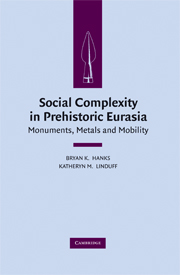Book contents
- Frontmatter
- Contents
- Contributors
- Foreword: From Myth to Method: Advances in the Archaeology of the Eurasian Steppe
- CHAPTER 1 Introduction: Reconsidering Steppe Social Complexity within World Prehistory
- PART ONE FRAMING COMPLEXITY
- PART TWO MINING, METALLURGY, AND TRADE
- CHAPTER 7 Introduction
- CHAPTER 8 Formation of the Eurasian Steppe Belt Cultures: Viewed through the Lens of Archaeometallurgy and Radiocarbon Dating
- CHAPTER 9 Late Prehistoric Mining, Metallurgy, and Social Organization in North Central Eurasia
- CHAPTER 10 The Bronze-Using Cultures in the Northern Frontier of Ancient China and the Metallurgies of Ancient Dian Area in Yunnan Province
- CHAPTER 11 Production and Social Complexity: Bronze Age Metalworking in the Middle Volga
- CHAPTER 12 Early Metallurgy and Socio-Cultural Complexity: Archaeological Discoveries in Northwest China
- PART THREE FRONTIERS AND BORDER DYNAMICS
- PART FOUR SOCIAL POWER, MONUMENTALITY, AND MOBILITY
- Index
CHAPTER 11 - Production and Social Complexity: Bronze Age Metalworking in the Middle Volga
from PART TWO - MINING, METALLURGY, AND TRADE
Published online by Cambridge University Press: 26 January 2010
- Frontmatter
- Contents
- Contributors
- Foreword: From Myth to Method: Advances in the Archaeology of the Eurasian Steppe
- CHAPTER 1 Introduction: Reconsidering Steppe Social Complexity within World Prehistory
- PART ONE FRAMING COMPLEXITY
- PART TWO MINING, METALLURGY, AND TRADE
- CHAPTER 7 Introduction
- CHAPTER 8 Formation of the Eurasian Steppe Belt Cultures: Viewed through the Lens of Archaeometallurgy and Radiocarbon Dating
- CHAPTER 9 Late Prehistoric Mining, Metallurgy, and Social Organization in North Central Eurasia
- CHAPTER 10 The Bronze-Using Cultures in the Northern Frontier of Ancient China and the Metallurgies of Ancient Dian Area in Yunnan Province
- CHAPTER 11 Production and Social Complexity: Bronze Age Metalworking in the Middle Volga
- CHAPTER 12 Early Metallurgy and Socio-Cultural Complexity: Archaeological Discoveries in Northwest China
- PART THREE FRONTIERS AND BORDER DYNAMICS
- PART FOUR SOCIAL POWER, MONUMENTALITY, AND MOBILITY
- Index
Summary
Researchers consider metal production to have been second only to pastoralism as a form of productive economic activity in the Middle Volga region throughout the Bronze Age (Vasil'ev et al. 2000: 8). This presents an interesting paradox. There is virtually universal acceptance of the high social significance of early metal making in the steppes, as shown particularly by the integral role of metal artifacts in kurgan burial rites. However, metal appears to have been produced on a relatively small scale in many areas, including the Middle Volga, for much if not all of the Bronze Age. Although many archaeologists have assumed that metal was important in the past because of its “self-evident usefulness or inherent attractiveness” (Sherratt 1997: 103), its value was foremost a product of human knowledge, labor, and interactions, in which even very small-scale production could have been of considerable local importance. The association of metalwork with kurgan burial rites indicates that metal was not perhaps necessary for survival but may have been a social necessity, at least for a certain level of social identity that could be negotiated or maintained in interactions surrounding the production and acquisition of metalwork. What is less clear is how participation in metal making, as opposed to maximization of output or control of product, contributed to the emergence of social complexity in the Middle Volga or elsewhere.
The metal-making process involved a temporally extended sequence of activities that were often carried out by different hands in different places (Fig. 11.1).
- Type
- Chapter
- Information
- Social Complexity in Prehistoric EurasiaMonuments, Metals and Mobility, pp. 187 - 214Publisher: Cambridge University PressPrint publication year: 2009
- 4
- Cited by

